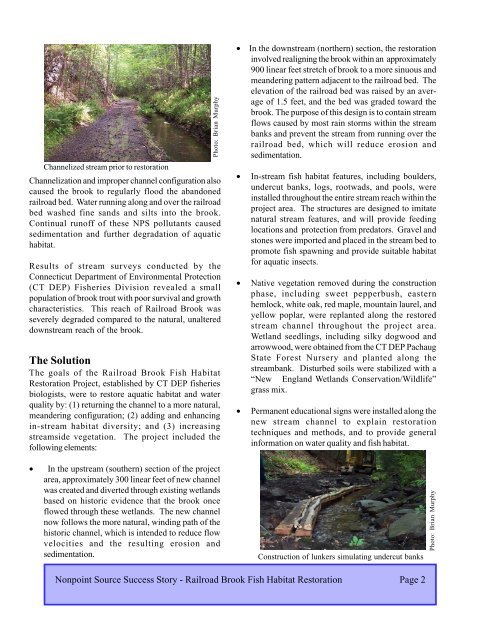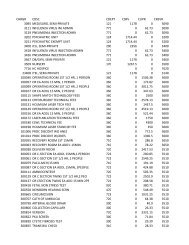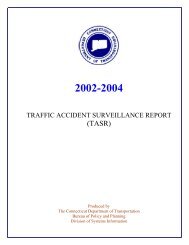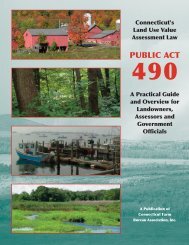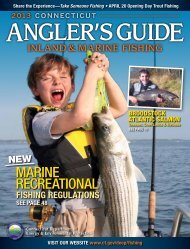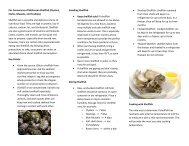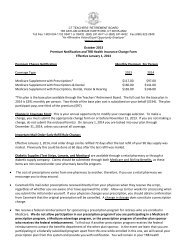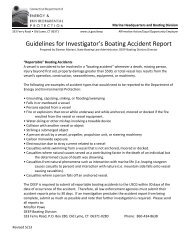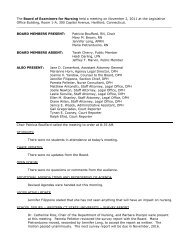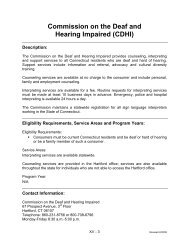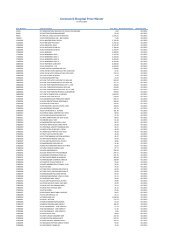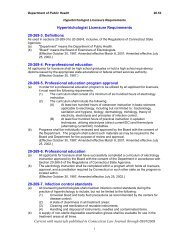Railroad Brook Fish Habitat Restoration Project - CT.gov
Railroad Brook Fish Habitat Restoration Project - CT.gov
Railroad Brook Fish Habitat Restoration Project - CT.gov
You also want an ePaper? Increase the reach of your titles
YUMPU automatically turns print PDFs into web optimized ePapers that Google loves.
Channelized stream prior to restoration<br />
Channelization and improper channel configuration also<br />
caused the brook to regularly flood the abandoned<br />
railroad bed. Water running along and over the railroad<br />
bed washed fine sands and silts into the brook.<br />
Continual runoff of these NPS pollutants caused<br />
sedimentation and further degradation of aquatic<br />
habitat.<br />
Results of stream surveys conducted by the<br />
Connecticut Department of Environmental Protection<br />
(<strong>CT</strong> DEP) <strong>Fish</strong>eries Division revealed a small<br />
population of brook trout with poor survival and growth<br />
characteristics. This reach of <strong>Railroad</strong> <strong>Brook</strong> was<br />
severely degraded compared to the natural, unaltered<br />
downstream reach of the brook.<br />
The Solution<br />
The goals of the <strong>Railroad</strong> <strong>Brook</strong> <strong>Fish</strong> <strong>Habitat</strong><br />
<strong>Restoration</strong> <strong>Project</strong>, established by <strong>CT</strong> DEP fisheries<br />
biologists, were to restore aquatic habitat and water<br />
quality by: (1) returning the channel to a more natural,<br />
meandering configuration; (2) adding and enhancing<br />
in-stream habitat diversity; and (3) increasing<br />
streamside vegetation. The project included the<br />
following elements:<br />
Photo: Brian Murphy<br />
• In the downstream (northern) section, the restoration<br />
involved realigning the brook within an approximately<br />
900 linear feet stretch of brook to a more sinuous and<br />
meandering pattern adjacent to the railroad bed. The<br />
elevation of the railroad bed was raised by an average<br />
of 1.5 feet, and the bed was graded toward the<br />
brook. The purpose of this design is to contain stream<br />
flows caused by most rain storms within the stream<br />
banks and prevent the stream from running over the<br />
railroad bed, which will reduce erosion and<br />
sedimentation.<br />
• In-stream fish habitat features, including boulders,<br />
undercut banks, logs, rootwads, and pools, were<br />
installed throughout the entire stream reach within the<br />
project area. The structures are designed to imitate<br />
natural stream features, and will provide feeding<br />
locations and protection from predators. Gravel and<br />
stones were imported and placed in the stream bed to<br />
promote fish spawning and provide suitable habitat<br />
for aquatic insects.<br />
• Native vegetation removed during the construction<br />
phase, including sweet pepperbush, eastern<br />
hemlock, white oak, red maple, mountain laurel, and<br />
yellow poplar, were replanted along the restored<br />
stream channel throughout the project area.<br />
Wetland seedlings, including silky dogwood and<br />
arrowwood, were obtained from the <strong>CT</strong> DEP Pachaug<br />
State Forest Nursery and planted along the<br />
streambank. Disturbed soils were stabilized with a<br />
“New England Wetlands Conservation/Wildlife”<br />
grass mix.<br />
• Permanent educational signs were installed along the<br />
new stream channel to explain restoration<br />
techniques and methods, and to provide general<br />
information on water quality and fish habitat.<br />
• In the upstream (southern) section of the project<br />
area, approximately 300 linear feet of new channel<br />
was created and diverted through existing wetlands<br />
based on historic evidence that the brook once<br />
flowed through these wetlands. The new channel<br />
now follows the more natural, winding path of the<br />
historic channel, which is intended to reduce flow<br />
velocities and the resulting erosion and<br />
sedimentation.<br />
Construction of lunkers simulating undercut banks<br />
Photo: Brian Murphy<br />
Nonpoint Source Success Story - <strong>Railroad</strong> <strong>Brook</strong> <strong>Fish</strong> <strong>Habitat</strong> <strong>Restoration</strong> Page 2


